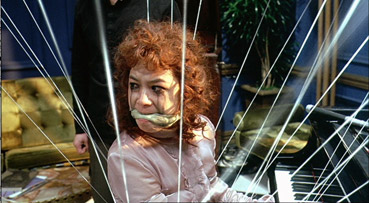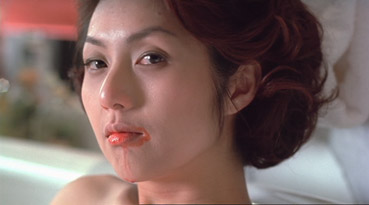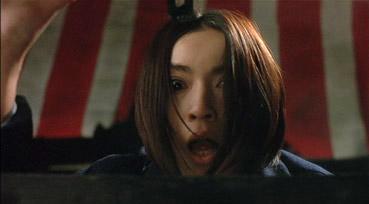|
Multi-story
horror films, once the mainstay of British studio Amicus
(Dr. Terror's House of Horrors, Tales
From The Crypt, Asylum, etc.),
have been out of fashion of late. It's not hard to see why, with the restrictions of the short film format in terms of
character and plot development, the difficulty of marketing
such a work without sounding like a carnival barker (THREE
stories of the grotesque! THREE times the terror!) and the
fact that they never set the box office alight or end up
on many Best Film lists amongst the reasons. Inevitably, they also fall victim
to the natural selection game, where one story tends to
attract more praise than the others, and potential viewers
are left with the prospect of sitting through an hour of
mediocre material to get to the good stuff. Not a great way to pull
in the crowds.

Having
different directors handle different stories may help the
boys in marketing, but it doesn't always proffer the results
that the name brands would lead us to expect. Then again, outside of the horror
genre, last year's Tickets
proved that three very different directors – Ermanno Olmi,
Abbas Kiarostami and Ken Loach – could indeed pull together
to make an engrossing three-story piece. But if you're going
to do it with horror, and in the Far East, just who do you
get on board? Well how about Fruit Chan (best known in the
UK for his excellent 1997 Made
in Hong Kong / Xianggang zhizao), Park Chan-wook (who helmed the celebrated Vengeance
Trilogy, but you knew that) and Miike Takashi (oh come on,
if you don't know this name by now...).
These
are three separate stories with no obvious link other than
their dark tone and their indifference to any sort of taste
barrier. In Fruit Chan's Dumplings, a fading TV
actress visits a woman whose special brand of dumplings
are reputed to restore youth and fertility, but just what
is the secret ingredient? In Park Chan-wook's Cut,
a film director is held captive by a disgruntled extra,
who presents him with a nightmarish dilemma involving his
wife and a small child. In Miike Takashi's Box,
a solitary writer suffering from a recurring nightmare recalls
a terrible incident from her youth.
I'll
say up front that all three stories contain elements that
most horror fans will find familiar, to the degree that
a couple of the plot twists will not prove quite as surprising
as they were perhaps intended. But all three still manage
to be both engrossing and disturbing, and when I say disturbing
I mean it – there is stuff here that will give even some
genre fans a start, and the film as a whole is most definitely not for the squeamish.
The stories also wander into dangerous thematic territory,
and if you're easily offended then you'll certainly find
material here to get you writing protest letters. But it
is the nature of modern horror to take you places you will
not feel comfortable, and after 100 years of cinema there
are only so many taboos left to bust.

Not
that this will come as surprise to anyone familiar with
the films of Park Chan-wook, who in Sympathy
for Mr. Vengeance, Oldboy
and Lady Vengeance has already dragged
us into the darker corners of the human experience. His
contribution certainly fits very comfortably into his overall
oeuvre, playing almost like the climactic sequence of a
fourth Vengeance film, complete with unpleasant
revenge plans, dark revelations, and a final twist that
seems to have been designed purely to punish the audience.
If
your only exposure to the talents of Fruit Chan is Made
in Hong Kong, however, his cheerfully unflinching
approach to very adult subject matter might catch you by
surprise (it bloody did me). Though you should work
out just what 'the secret ingredient' is very early in the
story, this appears to be intentional and just makes
what follows even more suggestively (and occasionally explicitly)
horrible – that there are flashes of black comedy here and
there only seems to heighten the sense of suffocating nightmare
of the piece. It may end in the inconclusive manner of many
a horror short, but Chan still pulls of a swift, subtle,
but gloriously creepy frisson to send you into Park's segment.
Probably
the biggest surprise of all comes from Miike Takashi, a
director who in the past has openly embraced shock tactics,
sometimes seemingly just for the fun of doing so. Here he is
the very model of suggestive restraint, creating a film
that plays more like Nakata Hideo on a quiet day than what we might redard as traditional
Miike. There is no final, Audition-like
switch to graphic horror here – the story ends as it has
plays out, quietly and creepily, a surprisingly low-key
conclusion following the body blows delivered by his colleagues.
As
with all good horror, the three tales also function effectively
on a subtextual level. Dumplings works as a
critique of modern society's obsession with a particular
type of beauty and the extreme lengths some will go to maintain
it, Box examines the darker side of sibling rivalry
and father-daughter relationships, and Cut suggests
something of the filmmaker's own fears and paranoia, a cinematic
equivalent of Stephen King's writer-as-victim novels such
as Misery and The Dark Half.

Technically
all three stories are impressively handled, with some lovely
editing and cinematography (Dumplings was shot
by the legendary Christopher Doyle and Cut by Park's
regular lensman Jeong Jeong-hun), even if Park initially
seems to have overdosed on David Fincher-style CGI flying
camera tricks. All three directors are on form and very
comfortable with the short film format, establishing their
characters and settings quickly and with clarity before moving
swiftly into the narrative proper. Park even takes
time to play an opening trick on the unwary, but one that
echoes memorably later in the story.
Anyone
interested in the work of any of these filmmakers will want to check this out, and if you've been following
the work of all three – as you should have been – then there is an element
of cinematic pig heaven about the enterprise. But be warned.
The English title Three... Extremes is well
chosen – there's some dark and nasty stuff in here, guaranteed
to thrill those who like cinema to push the envelope, but
also to offend the sensitive. Which is what extreme horror
cinema is all about, isn't it?
Framed
1.85:1 and anamorphically enhanced, for the most part the
image looks very good, with a fine level of detail, excellent
colour and contrast and solid black levels. There is some
very slight juddering on fast camera moves, but these are
few and far between. A weeny bit of edge enhancement is
sometimes visible.
The
5.1 sound is very clear and well mixed, especially in Cut,
where some nice games are played with the surrounds. Miike's
piece uses sound in a sometimes jarring manner, with
very quiet voices and silences suddenly interrupted by thunderous
sound effects, so be warned. As usual with Tartan, Dolby
2.0 stereo, Dolby 5.1 surround and DTS tracks are available.
The 5.1 and DTS are virtually identical, and are definitely
the way to go.
The
Making of Three... Extremes (14:57) is actually
an EPK-style featurette about the making of Dumplings
– the other two stories don't get a look-in. There are easily
read, fixed English subtitles throughout, even when Bai
Ling talks in English. This is not one to be watched before
you see the film, by the way.
The
Original Theatrical Trailer (1:39)
sells the film very much on its horror elements.
There is also the usual Trailer Reel, which features trailers
for five other Tartan releases, including the feature length
version of Dumplings.
A
meaty trio of atmospheric and sometimes disturbing horror
works from three of Asian Cinema's brightest lights, well
presented if short on extra features on Tartan's DVD. The
short film format is well used – indeed, it's hard to imagine
the expanded feature-length version of Dumplings
working as effective as the briskly told tale here.* Horror
fans looking for a serious fix need search no further.
* It does, actually, but for different reasons than expected.
The convention of family name first has been used for all Japanese and Korean names throughout this review.
|